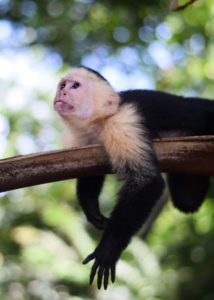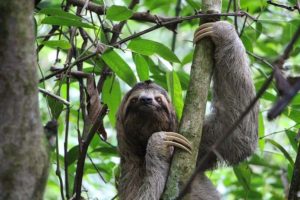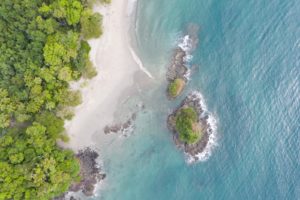 Manuel Antonio National Park is a must-visit for nature lovers and national park enthusiasts. It’s the most visited park in Costa Rica, despite being the smallest of them all.
Manuel Antonio National Park is a must-visit for nature lovers and national park enthusiasts. It’s the most visited park in Costa Rica, despite being the smallest of them all.
This wilderness area is located on the Pacific coast of the country, in the province of Puntarenas. It is about 157 km south of San José by road and 7 km south of the town of Quepos. The warm beaches and the greenery of the forest come together in one place, resulting in a natural paradise. In addition to beaches, the park has a very humid tropical forest where species of flora and fauna endangered coexist. Among the ecosystems that make it up are mangroves, marine environments, islands, and small rivers.
With such a varied ecosystem, many species of animals are found here. So, while visiting the park, keep your eyes wide open to spot two and three-toed sloths, frogs, snakes, lizards, poisonous frogs, and even hummingbirds! And if you also hope to see primates, Manuel Antonio National Park is the place to be. This park is home to squirrel monkeys, white-faced capuchin monkeys, and howler monkeys that live up to their name by making a lot of noise.
Visit Manuel Antonio National Park during an international volunteer program
What beaches can I visit in the national park?
In the heart of this stunning natural setting is one of Costa Rica’s most emblematic beaches, Playa Manuel Antonio. With the jungle very close and beautiful emerald-colored waters, this white sand beach is perfect for relaxing and refreshing in its waters. Since hundreds of visitors enter Manuel Antonio National Park daily and the beach is not excessively large, overcrowding is usually the dominant note.
But Playa Manuel Antonio is not the only option for taking a dip in the national park. In addition to this, within the park, there are also Puerto Escondido and Espadilla Sur beaches. The first, as its name indicates, is the most hidden and relaxed of all the beaches. It is located in a 650-meter-long cove, creating an amazing landscape. Espadilla Sur is about 3.5 kilometers long and is surrounded by vegetation. Due to its length, it is usually not too crowded, allowing you to enjoy a soothing afternoon. Undoubtedly, these will be your moments of rest from the adventure of your international volunteer experience.
Animals you can’t miss on the park visit
 Although we have previously introduced the fauna inhabiting this natural jewel, there are two animals that tourists seek the most to observe and photograph. Within Manuel Antonio National Park, two species of Costa Rica’s most iconic animal, the two-toed and three-toed sloths, coexist. If you want to see this animal in its natural habitat, this national park is the ideal place to do it. How many of them will you see during your volunteer experience in Costa Rica?
Although we have previously introduced the fauna inhabiting this natural jewel, there are two animals that tourists seek the most to observe and photograph. Within Manuel Antonio National Park, two species of Costa Rica’s most iconic animal, the two-toed and three-toed sloths, coexist. If you want to see this animal in its natural habitat, this national park is the ideal place to do it. How many of them will you see during your volunteer experience in Costa Rica?
On the other hand, this park is home to the white-faced capuchin monkey. During the walk along the trails, you can find them crossing these trails or jumping in the trees. This animal is an endangered species due to the imminent disappearance of its natural habitat. And did you know? Capuchin monkeys have learned to steal food and backpacks from tourists!
Don’t hesitate anymore! Dare to discover Costa Rica by volunteering in America and getting to know its inhabitants, flora, and fauna up close. We’re waiting for you!





